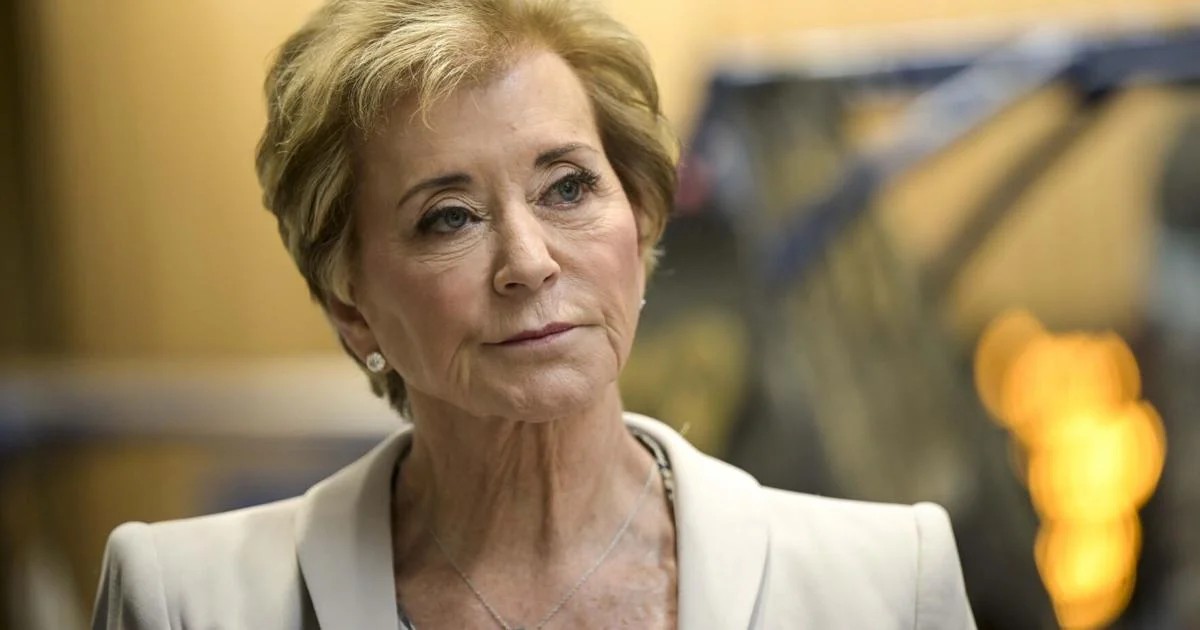
U.S. Secretary of Education Linda McMahon visited Bozeman business owners and students on the Montana State University campus on Friday alongside Gov. Greg Gianforte as part of her national “Returning Education to the States Tour.”
McMahon is touring all 50 states months after President Donald Trump signed an executive order to eliminate the Department of Education. While a federal department cannot be formally eliminated through an executive order, the U.S. Supreme Court permitted the administration to eliminate 4,000 jobs at the department, which represented about 40% of its workforce.
Gianforte addressed both McMahon and MSU President Brock Tessman, who took the position earlier this year.
“Both of you, welcome to your new jobs,” Gianforte said.
McMahon responded, turning to Tessman: “Hopefully yours lasts longer than mine.”
Montana was the 19th stop on McMahon’s tour, according to a press release from Gianforte’s Office.
McMahon told the press following the roundtable the federal funds for Title I, IDEA and grants — which fund education for low-income and special-needs students — will still flow to Montana “regardless of which agency they go through.”
Gianforte said federal funding comes with red tape and administrative costs and makes up a smaller percentage of district funding compared to state and local sources.
While grade school doesn’t depend as much on federal funding, it’s important for universities and college students. The last federal funding bill, known as the “Big, Beautiful, Bill,” capped graduate student loans at about $50,000, and students in more expensive programs may need to take out private loans to make up the difference.
About one-third of the University of Montana law school students utilize the GRAD Plus loans.
Getting the cost of education down is a goal, McMahon said, and the objective behind capping the loan was to make sure students don’t take out loans they can’t pay off.
“It may be that the job that that student will eventually get will not even allow him or her to have the kind of salary or whatever that they could even repay that loan,” McMahon said. “By capping it, one of the goals is to create downward pressure on universities to help reduce their costs.”
Students owe a collective $1.7 trillion in debt for higher education in the U.S., McMahon said.
“We want to bring that down and make college more affordable for everyone,” she said.
Gianforte said students are worried about the cost of education, whether it’s a traditional four-year college or a certificate program.
“Historically, we’ve only focused on more scholarship dollars, not actually making the system more efficient,” Gianforte said. “We have to work to maintain the scholarship dollars, but we’ve also got to consider the expense side of the ledger without compromising quality.”
Gianforte pointed to the Montana University System’s “one-two-free” dual enrollment program, which allows high school students to earn college credits for free as a local solution to help with costs.
“We have high school graduates now starting college with a backpack full of college credits, and that can dramatically reduce the cost of college,” Gianforte said.
The Board of Regents’ “sprint degrees” for students looking to pursue careers like nursing, elementary education or automotive technology in a 2.5-year timeline are another option for students looking to advance their careers, but who need something outside the traditional four-year track, which Gianforte mentioned as another reduced-cost option for students.
Gallatin College student Tage Olson said the reason he chose to go to school there was its affordability. When Gianforte asked what he hoped to get out of the program, Olson responded, “I hope to graduate with little debt.”
Studying cybersecurity, Olson said starting pay is good, so he’s expecting to pay off loans pretty quickly.
Bozeman-based technology and manufacturing company leaders from Aurora Innovation and Johnson Metal Works talked about using talent from specialized certificate programs like carpentry, and even fighting over candidates when they first got off the ground.
“That’s why you’re on opposite sides of the table,” Tessman said to laughter in the room.
Also present at the roundtable was Superintendent Hedalen and Commissioner of Higher Education Clayton Christian.
Nicole Girten is the education reporter for the Ravalli Republic and the Missoulian.
You must be logged in to react.
Click any reaction to login.
Love
0
Funny
0
Wow
0
Sad
0
Angry
0
Want to see more like this?
Get our local education coverage delivered directly to your inbox.
* I understand and agree that registration on or use of this site constitutes agreement to its user agreement and privacy policy.
Nicole Girten
Education reporter for the Ravalli Republic & Missoulian
Get email notifications on {{subject}} daily!
Your notification has been saved.
There was a problem saving your notification.
{{description}}
Email notifications are only sent once a day, and only if there are new matching items.
Followed notifications
Please log in to use this feature
Log In
Don’t have an account? Sign Up Today



